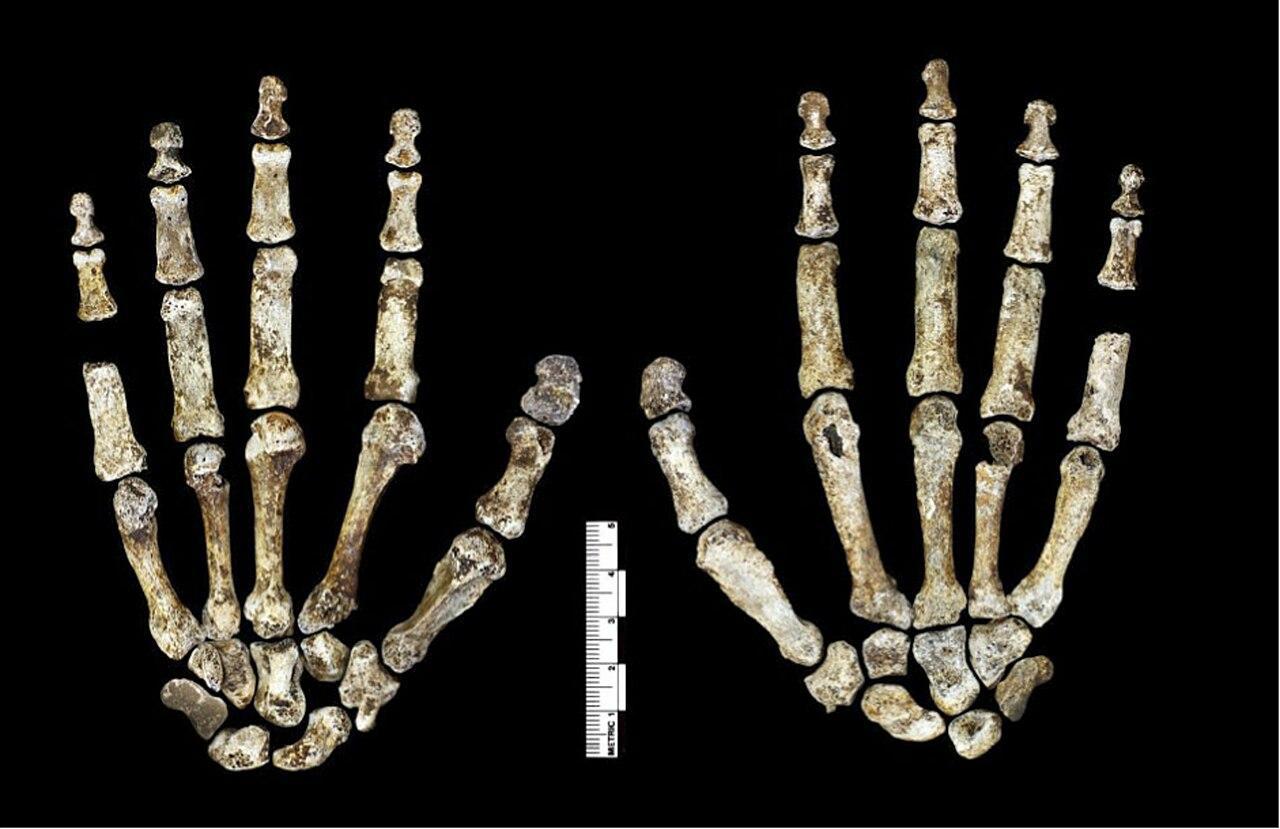World’s Oldest Burial Site Strikes Debate Over Human Ancestors and God
Paleontologists working at an ancient burial site in South Africa believe they have unearthed evidence to suggest that an older, distant relative of modern homo sapiens may have been far more intelligent than previously thought, despite their much smaller brain size.
The new discovery suggests the ancient hominin species, Homo Naledi, was more intelligent than previously thought and engaged in complex behavior. This unexpected revelation made by the researchers has begun to challenge our current understanding of human evolution. Ultimately, the findings could challenge our understanding of human evolution.
Researchers Uncover Remains Deep Inside a Cave
A research team, led by the esteemed paleoanthropologist Lee Berger, unearthed the remains of several Homo Naledi in South Africa back in 2023. These remains, which appear to have been intentionally buried, mark a significant discovery in the field of paleoanthropology.

Source: Wikimedia
The researchers had been working in the Rising Star cave system, which is part of the UNESCO World Heritage site, the Cradle of Humans, when they uncovered the remains around 30 meters (98.4 feet) below the surface of the site in Johannesburg.
Homo Naledi
According to the Smithsonian, the now-extinct Homo Naledi was a small-statured Stone Age, tree-climbing hominin species. Despite knowing little about the species, researchers have suggested that Homo Naledi had much smaller brains when compared to modern humans.

Source: Wikimedia
The species was previously discovered back in 2013 during an expedition led by Berger into the Rising Star cave system. Between November 2013 and March of the following year, over 1550 fragments from up to 15 Homo Naledi were recovered from the cave.
The Oldest Hominins Ever Discovered
Speaking on the most recent discovery, made during a series of papers published by eLife, Berger explains that the finds are some of the oldest hominins ever recorded.

Source: Wikimedia
“These are the most ancient interments yet recorded in the hominin record, earlier than evidence of Homo sapiens interments by at least 100,000 years,” he wrote.
Recent Discovery Begins to Rewrite History
The discovery of the remains has begun to initiate a significant shift in our understanding of hominin evolution.

Source: Wikimedia
Previously, researchers were under the impression that the development of larger brains witnessed in Neanderthals and Homo sapiens led to the introduction of complex “meaning-making” practices such as burying the dead.
200,000-Year-Old Burials
Prior to the discovery of the site, the oldest known burials were found in parts of Africa and the Middle East. The remains were of Homo sapiens, stretching back around 100,000 years.

Source: Wikimedia
However, those unearthed by Berger and his team in South Africa are almost twice as old and could date back to around 200,000 BCE.
Characteristics of the Homo Naledi
The Homo Naledi are named after the Rising Star cave system in which they were first discovered. According to Science Alert, they stood around five feet tall and had brains the size of an orange.

Source: Wikimedia
The Homo Naledi, with their uniquely curved fingers and toes, had hands designed for tool use and feet that enabled them to walk upright. These distinct features further underscore the complexity of their evolutionary path.
Homo Nadeli Deliberately Buried Their Dead
The remains of many of the Homo Naledi were discovered in oval-shaped holes. According to the researchers who worked at the site, each of the holes was intentionally dug before the remains were placed within and covered with dirt.

Source: Wikimedia
“These discoveries show that mortuary practices were not limited to H. sapiens or other hominins with large brain sizes,” the researchers said.
Ancient Hominins Capable of Complex Cognitive Behaviour
Several other aspects of the site lend credence to the idea that Homo Naledi were capable of complex cognitive and emotional behavior, noted the researchers.

Source: Wikimedia
Within one portion of the cave, researchers discovered several etchings of geometric shapes, including a “rough hashtag figure” engraved into a smoothed section of the wall.
The Homo Naledi’s Role in the Evolution of Hominins
The evidence of deliberate burials coupled with the etchings was enough for Berger to suggest that the Homo Naledi may have played a role in the cognitive evolution of early hominins.

Source:
“That would mean not only are humans not unique in the development of symbolic practices, but may not have even invented such behaviors,” said Berger.
Berger Faces Backlash
Statements about the complexity of the Homo Naledi have previously led to backlash for Berger, with many in the paleontology community suggesting he was too quick to jump to conclusions without proper evidence.

Source: Freepik
Speaking on the criticism he received in 2015 for his theory postulating the Homo Naledi was capable of more than their small brain size suggests, Berger said, “That was too much for scientists to take at that time. We think it’s all tied up with this big brain. We’re about to tell the world that’s not true.”
The Implications of the Discovery
Regarding the research’s implications, co-author Agustín Fuentes, a professor of anthropology at Princeton University, explained that the discovery of Homo Naledi could revolutionize our understanding of human evolution, sparking a new era of research and discovery.

Source: Wikimedia
“Burial, meaning-making, even ‘art’ could have a much more complicated, dynamic, non-human history than we previously thought,” wrote the scientist.
Religion Has Been Around Long Before Humans
If these findings did belong to the Homo Naledi, then there is a chance that religion and art were in our lineage long before we developed our more sophisticated brains.

Source: Jametlene Reskp/Unsplash
“We now face the prospect that a creature before humans was contemplating an afterlife. It completely changes how we have to think about human evolution,” said anthropologist Lee Berger, who has led the Rising Star investigations.
The Potential Importance of the Study
An anthropologist at the University of Missouri noted that the research, which they were not involved in, “would be of considerable potential importance” if confirmed.

Source: Freepik
“I look forward to learning how the disposition of remains precludes other possible explanations than intentional burial, and to seeing the results once they have been vetted by peer review,” she told AFP.
Debunking the Study
In 2023, the journal eLife hosted three reviewed pre=prints by the Rising Star research team that claimed the skeletal remains indicated deliberate burial practices. However, the revolutionary idea may not prove that our ancestors buried their dead.

Source: Freepik
A group of experts with specializations in biological anthropology, archaeology, geochronology, and rock art have called for a deeper dig into the findings.
The Evidence Isn’t Strong Enough
The research team behind the peer-reviewed critique titled “No scientific evidence that Homo Naledi buried their dead and produced rock art“ published in the Journal of Human Evolution says the evidence is not compelling enough to support the deliberate burial of the dead by Homo Naledi.

Source: Wikimedia
The paper also states that the evidence found does not support the claim that Homo Naledi made the engravings.
Need More Analysis
“We really need substantial additional documentation and scientific analyses before we can rule out that natural agents and post-depositional processes were responsible for the accumulation of bodies/body parts and to prove the intentional excavation and filling of pits by Homo naledi,” Professor Martinón-Torres said.

Source: Freepik
“Detailed analyses are also needed to demonstrate that the so-called ‘engravings’ are indeed human-made marks, as marks like these can be produced as a product of natural weathering or animal claws,” said Dr. Garate.
No Evidence to Support Claims
Professor Herries said, “We have no evidence that Homo naledi lit fires in the cave. The purported burning locations could simply be from manganese staining, and we have not yet dated the charcoal within the cave. Charcoal from natural fires is not uncommon in caves.”

Source: Freepik
Professor Petraglia added, “Unfortunately, there is a distinct possibility that the so-called stone artifact next to the hominin hand is a geofact, and not a product of stone tool flaking by Homo naledi.”
The Possible Burials By Ancient Ancestors
Humans, and even our ancestors, are not the only species to have death rituals. They happen across several animal species, showing that it is in some of our nature to show significance to life.

Source: Freepik
These behaviors from other species are not dissimilar to how humans are mourning and ritualizing the dead.
Elephants Mourn Lost Ones
In 2004, observers saw an elephant in Kenya cover the bodies of a mother and child it had trampled to death with leaves before leaving the scene. Further studies found that elephants, which are highly intelligent animals, inspect the bodies of their own heard before covering them with leaves and branches.

Source: Freepik
This suggests that elephants are generally aware of death, and often mourn their losses by staying with the body for some time.
Crows Call Out
Like elephants, crows—another highly intelligent species—gather near the body of a lost companion and call out to each other.

Source: Alexas Fotos/Pexels
However, this response to death is not the same as mourning. Scientists believe that the crows understand the relationship between death and future threats, and gathering near the body helps crows assess what happened so they can avoid dangerous situations.
Chimps Mourn the Dead
Similar to humans, chimpanzees have extremely complex social structures. While chimpanzees do mourn those they have lost, scientists are not certain if some behavior, like chimpanzee mothers carrying around their lost infants for months, means that they recognize death.

böhringer friedrich/Wikimedia Commons
The behavior after death can seem distinctly human, as they often spend time with the lost members and tend to the body.
Giraffes Grieve
In 2012, a zoologist in Zambia watched as a mother giraffe spent two hours licking and nudging her lost newborn. They noted that the mother splayed her legs to get closer to the infant, a rare behavior in giraffes.

Source: Pixabay/Pexels
Observers have noted this behavior twice, showing that these gentle creatures mourn their dead.
Dolphins Have Ritualistic Ceremonies
Mourning does not take place just on land. Dolphins are known to spend time with the bodies of their lost companions. They also use their heads and backs to hold up calves who did not survive for 30 minutes before letting them go.

Source: HAMID ELBAZ /Pexels
While scientists do not know if this is a sign of grief, dolphins are highly intelligent animals with well-developed brain regions that process emotions like grief.
